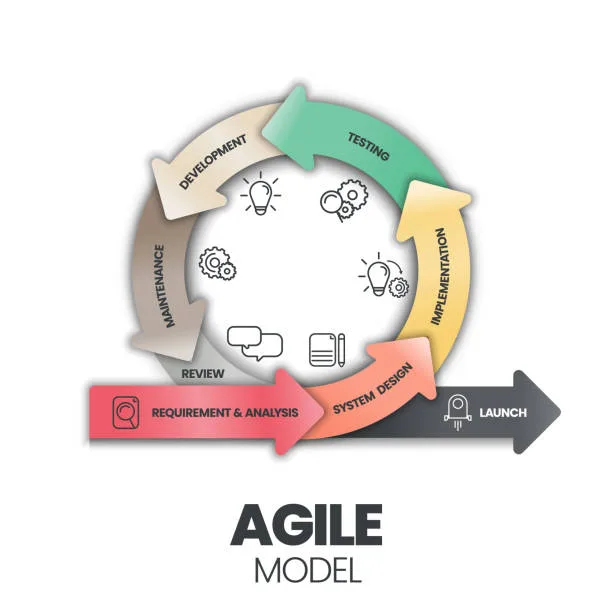
In today’s fast-paced and ever-evolving business landscape, adaptability and efficiency are key to staying ahead of the competition. One powerful tool that has revolutionized the way projects are managed is Agile Methodologies. By embracing Agile principles, organizations can break free from traditional, rigid project management approaches and unlock a more streamlined and flexible process.
In this article, we will delve into the world of Agile Methodologies and explore how it can empower businesses to enhance collaboration, increase productivity, and deliver exceptional results. Whether you’re a seasoned project manager or someone looking to optimize your team’s workflow, this guide will provide you with valuable insights and practical tips to harness the power of Agile Methodologies.
Also, From understanding the core principles to implementing Agile practices, we’ll walk you through the steps to transform your project management process into a well-oiled machine. Get ready to tap into the immense potential of Agile and take your projects to new heights of success.
However, you can find all the information you’ve been searching for on this blog or in our future articles, which are accessible by clicking here
Benefits of Using Agile Methodologies in Project Management
Agile Methodologies offer a plethora of benefits for project management. Firstly, Agile enables greater flexibility and adaptability, allowing teams to respond quickly to changes and deliver value to customers at a faster pace. By breaking down projects into smaller, manageable chunks called sprints, Agile empowers teams to prioritize and focus on high-value tasks, resulting in increased efficiency and productivity.
Another key advantage of Agile is improved collaboration. Agile promotes cross-functional teams, where individuals with different skills and expertise work together towards a common goal. This fosters better communication, knowledge sharing, and a sense of ownership, leading to higher quality outputs. Additionally, Agile methodologies encourage regular feedback and iteration, ensuring that the end product meets the customer’s requirements and expectations.
Furthermore, Agile methodologies promote transparency and visibility throughout the project lifecycle. By utilizing visual tools such as Kanban boards or Scrum boards, teams can easily track progress, identify bottlenecks, and make data-driven decisions. This enhanced visibility enables better project planning and resource allocation, resulting in optimized time and cost management.
In summary, the benefits of using Agile methodologies in project management are:
- Greater flexibility and adaptability
- Increased efficiency and productivity
- Improved collaboration and communication
- Regular feedback and iteration
- Enhanced transparency and visibility
Agile Project Management Statistics
To further emphasize the effectiveness of Agile methodologies, let’s take a look at some compelling statistics:
1. According to a survey conducted by the Project Management Institute (PMI), 71% of organizations reported using Agile approaches for their projects, indicating its widespread adoption across various industries.
2. The same study revealed that Agile projects are 28% more successful than traditional projects, highlighting the positive impact Agile methodologies have on project outcomes.
3. Another survey by McKinsey & Company found that Agile organizations are 1.5 times more likely to be top performers in their industries, demonstrating the competitive advantage Agile methodologies can provide.
These statistics reaffirm the value of Agile methodologies in project management and serve as a testament to its proven effectiveness in delivering successful projects.
Key Principles of Agile Methodologies
At the core of Agile methodologies are a set of principles that guide its implementation. These principles encourage collaboration, flexibility, and continuous improvement. Let’s explore the key principles of Agile:
1. Customer Collaboration over Contract Negotiation: Agile methodologies prioritize active customer involvement throughout the project. By collaborating closely with customers, teams can gather real-time feedback, adapt to changing requirements, and ensure the final product aligns with customer expectations.
2. Responding to Change over Following a Plan: Agile embraces change as a natural part of the project lifecycle. Instead of rigidly adhering to a predefined plan, Agile teams are prepared to adapt and pivot based on new information or customer feedback. This flexibility allows for quicker response to market demands and ensures the final product remains relevant and valuable.
3. Working Solutions over Comprehensive Documentation: Agile methodologies prioritize the delivery of working solutions over extensive documentation. By focusing on tangible outputs, teams can quickly validate ideas, gather user feedback, and make necessary adjustments. This iterative approach reduces the risk of developing a product that does not meet customer needs.
4. Collaboration and Communication over Hierarchical Structures: Agile promotes self-organizing, cross-functional teams, where individuals work together towards a common goal. This flattens hierarchies, encourages open communication, and fosters a sense of ownership and accountability among team members. By leveraging the collective intelligence and skills of the team, Agile methodologies enable faster decision-making and problem-solving.
5. Continuous Improvement and Feedback over Perfection: Agile methodologies embrace an iterative approach, where teams continuously improve and refine their processes. Regular feedback loops allow for rapid course correction, identifying areas for improvement, and maximizing the value delivered to customers. By striving for continuous improvement, Agile teams can stay ahead of the competition and drive innovation.
These key principles form the foundation of Agile methodologies and provide a guiding framework for teams to deliver successful projects in a dynamic and ever-changing business environment.
Agile Project Management Frameworks – Scrum, Kanban, and Lean
The Agile methodologies encompass various frameworks that provide structure and guidance for project management. Three popular Agile frameworks are Scrum, Kanban, and Lean. Each framework has its unique characteristics and is suited for different project types and team dynamics. Let’s explore these frameworks in more detail:
Scrum
Scrum is one of the most widely adopted Agile frameworks, particularly in software development. It emphasizes iterative development, with projects divided into time-boxed iterations called sprints.
Also, Scrum teams have defined roles, including a Scrum Master who facilitates the process, a Product Owner who represents the customer, and the Development Team responsible for delivering the work. Scrum utilizes various artifacts, such as the Product Backlog, Sprint Backlog, and Burndown Chart, to track progress and ensure transparency.
Kanban
Kanban is a visual framework that focuses on workflow management and continuous delivery. Kanban boards visually represent the project’s workflow, with tasks moving through different stages from “To Do” to “In Progress” to “Done.”
Furthermore, this framework provides teams with a clear visualization of work in progress, bottlenecks, and resource availability. Kanban promotes a pull system, allowing team members to take on new tasks as they complete existing ones, ensuring a steady flow of work.
Lean
Lean is an Agile framework derived from the manufacturing industry, aiming to eliminate waste and maximize value. It emphasizes delivering value to the customer by systematically identifying and eliminating non-value-added activities. Lean focuses on continuous improvement, reducing cycle time, and optimizing resource utilization. The framework encourages teams to adopt a problem-solving mindset, streamline processes, and create a culture of continuous learning and improvement.
These Agile frameworks provide organizations with flexible and scalable approaches to project management, enabling teams to tailor their processes to specific project requirements and team dynamics.
Implementing Agile Methodologies in Your Project Management Process

Implementing Agile methodologies in your project management process requires careful planning and consideration. Here are some key steps to guide you through the implementation process:
1. Understand your project and team dynamics: Before adopting Agile, assess whether it is suitable for your project type and team structure. Consider factors such as project complexity, team size, and customer involvement. Agile methodologies work best for projects with evolving requirements and cross-functional teams.
2. Educate and train your team: Agile methodologies require a mindset shift and a deep understanding of the principles and frameworks. Provide training and resources to ensure your team members are equipped with the necessary knowledge and skills to embrace Agile practices.
3. Define project goals and scope: Clearly define project goals and scope to establish a shared understanding among team members. Agile methodologies encourage collaboration and active involvement of stakeholders in defining project requirements.
4. Select an Agile framework: Choose an Agile framework that best suits your project and team dynamics. Consider factors such as project complexity, team size, and level of customer involvement. Scrum, Kanban, and Lean are popular choices, each with its unique characteristics.
5. Establish Agile rituals and ceremonies: Implement Agile rituals and ceremonies to facilitate collaboration, transparency, and accountability. These may include daily stand-up meetings, sprint planning sessions, sprint reviews, and retrospectives. These rituals promote effective communication, progress tracking, and continuous improvement.
6. Embrace Agile tools and software: Leverage Agile project management tools and software to facilitate collaboration, visual tracking of work, and communication. These tools can help teams manage backlogs, track progress, and foster transparency among team members.
7. Encourage a culture of continuous improvement: Agile methodologies thrive in an environment that promotes continuous learning and improvement. Encourage your team members to share feedback, experiment with new approaches, and embrace a problem-solving mindset. Regular retrospectives can help identify areas for improvement and implement iterative changes.
By following these steps, you can effectively implement Agile methodologies in your project management process, leading to enhanced collaboration, increased productivity, and improved project outcomes.
Agile Project Management Best Practices
To further optimize your Agile project management process, consider incorporating these best practices:
1. Empower self-organizing teams: Encourage autonomy and empower team members to make decisions and take ownership of their work. Self-organizing teams are more likely to be engaged, innovative, and deliver high-quality outputs.
2. Foster open communication and transparency: Create an environment that promotes open and honest communication among team members. Regularly share progress, challenges, and lessons learned. Transparency builds trust and enables effective collaboration.
3. Prioritize backlog grooming: Regularly review and prioritize the product backlog to ensure it reflects the most valuable work. Collaborate with stakeholders to refine requirements, clarify user stories, and remove any ambiguities.
4. Embrace continuous integration and delivery: Implement practices that enable continuous integration and delivery of work. This ensures that changes are integrated and tested frequently, reducing the risk of integration issues and enabling faster feedback loops.
5. Encourage cross-functional collaboration: Foster collaboration between team members with diverse skills and expertise. Encourage knowledge sharing, pair programming, and cross-training to maximize the collective intelligence of the team.
6. Continuously monitor and adapt: Regularly monitor project metrics, such as velocity, cycle time, and customer satisfaction. Use this data to identify areas for improvement and adapt your processes accordingly. Agile methodologies thrive on continuous learning and adaptation.
By incorporating these best practices into your Agile project management process, you can further optimize your team’s workflow and drive successful project outcomes.
Agile Project Management Tools and Software
Agile project management tools and software play a crucial role in facilitating collaboration, tracking progress, and ensuring transparency. Here are some popular Agile tools and software that can support your Agile project management process:
1. Jira: Jira is a widely used Agile project management tool that offers features such as backlog management, sprint planning, and progress tracking. It allows teams to visualize their work, manage sprints, and collaborate effectively.
2. Trello: Trello is a Kanban-based project management tool that provides a visual representation of work in progress. It enables teams to create boards, add tasks, and move them through different stages. Trello is known for its simplicity and user-friendly interface.
3. Monday.com: Monday.com is a versatile project management tool that supports Agile methodologies. It offers features such as task tracking, time management, and team collaboration. Monday.com provides a customizable interface to fit different project management needs.
4. Asana: Asana is a popular project management tool that supports Agile practices. It allows teams to create and manage tasks, track progress, and collaborate in real-time. Asana offers features such as Gantt charts, Kanban boards, and integrations with other software.
5. Microsoft Azure DevOps: Microsoft Azure DevOps is a comprehensive toolset that supports Agile project management and software development. It provides features for backlog management, version control, continuous integration, and deployment. Azure DevOps integrates seamlessly with other Microsoft tools and services.
These tools and software can greatly enhance collaboration, visibility, and efficiency within your Agile project management process. Choose the one that best fits your team’s needs and preferences.
Agile Project Management Certifications and Training
For individuals looking to enhance their Agile project management skills, certifications and training programs are available. These certifications validate your knowledge and expertise in Agile methodologies and can boost your career prospects. Here are some popular Agile certifications:
1. Certified ScrumMaster (CSM): Offered by the Scrum Alliance, the CSM certification validates your understanding of Scrum principles and your ability to facilitate Agile project management practices.
2. Professional Scrum Master (PSM): Provided by Scrum.org, the PSM certification assesses your knowledge of Scrum and your ability to apply it effectively in real-world scenarios.
3. PMI Agile Certified Practitioner (PMI-ACP): Offered by the Project Management Institute (PMI), the PMI-ACP certification demonstrates your proficiency in Agile principles, practices, and tools.
4. SAFe Agilist (SA): Provided by Scaled Agile, the SAFe Agilist certification focuses on the Scaled Agile Framework (SAFe). It validates your understanding of Lean-Agile principles and your ability to lead Agile transformations in large organizations.
These certifications can enhance your credibility as an Agile project manager and provide you with valuable skills and knowledge to drive successful Agile projects.
Conclusion
The term “Agile methodologies” have revolutionized project management, enabling organizations to break free from traditional, rigid approaches and embrace a more flexible and collaborative way of working. By implementing Agile methodologies, businesses can enhance collaboration, increase productivity, and deliver exceptional results. From understanding the core principles to selecting the right Agile framework, implementing best practices, and leveraging tools and software, unlocking the power of Agile can transform your project management process into a well-oiled machine.
Embrace the immense potential of Agile methodologies and unlock new heights of success for your projects. Stay adaptable, continuously learn, and evolve with the ever-changing business landscape. With Agile, you can streamline your project management process, drive innovation, and stay ahead of the competition. Start your Agile journey today and unlock the power of Agile methodologies for your organization.
FAQs – Agile Methodologies
1. What are Agile Methodologies?
Agile Methodologies are iterative and collaborative approaches to software development and project management. They focus on adaptive planning, continuous improvement, and delivering value to customers through incremental development.
2. What are the core principles of Agile Methodologies?
The core principles of Agile Methodologies include customer collaboration over contract negotiation, responding to change over following a plan, delivering working software frequently, and valuing individuals and interactions over processes and tools.
3. Which Agile Methodologies are commonly used in software development?
Some commonly used Agile Methodologies in software development include Scrum, Kanban, Extreme Programming (XP), Lean Software Development, and Crystal.
4. What is Scrum and how does it work?
Scrum is an Agile framework that divides a project into time-boxed iterations called sprints. It employs roles like Scrum Master, Product Owner, and Development Team, along with ceremonies like Sprint Planning, Daily Standup, Sprint Review, and Sprint Retrospective.
5. How does Kanban differ from other Agile methodologies?
Kanban is a flow-based Agile approach that visualizes work on a Kanban board, allowing teams to limit work in progress and optimize the flow of tasks through their system, making it suitable for continuous delivery.
6. What is Extreme Programming (XP), and what are its key practices?
Extreme Programming (XP) is an Agile methodology that emphasizes practices like Test-Driven Development (TDD), Pair Programming, Continuous Integration, Refactoring, and Simple Design.
7. How does Agile support project adaptability and change management?
Agile methodologies support project adaptability through iterative development, frequent feedback, and incremental delivery, allowing teams to respond effectively to changing requirements and priorities.
8. What are the advantages of using Agile Methodologies?
Some advantages of Agile Methodologies include faster time-to-market, improved customer satisfaction, increased collaboration, better risk management, and enhanced team morale and productivity.
9. Can Agile methodologies be applied to non-software projects?
Yes, Agile methodologies can be applied to various non-software projects like marketing campaigns, product development, construction projects, and more, to improve project outcomes and adaptability.
10. How do Agile teams handle project estimation and planning?
Agile teams often use techniques like relative estimation (story points), planning poker, and velocity to estimate effort and plan project iterations or sprints effectively.
11. What challenges might teams face when adopting Agile methodologies?
Challenges in Agile adoption can include resistance to change, difficulties in breaking down large tasks, inadequate team collaboration, and challenges in scaling Agile for larger projects or organizations.
12. How can organizations measure the success of Agile implementations?
Organizations can measure Agile success using various metrics like lead time, cycle time, customer satisfaction, team velocity, and the number of defects found and resolved during iterations.
13. What role does continuous improvement play in Agile methodologies?
Continuous improvement is a key aspect of Agile methodologies, encouraging teams to regularly reflect on their processes and performance during retrospectives and implement changes to enhance efficiency and quality.
14. Are there any certifications available for Agile methodologies?
Yes, there are several Agile certifications available, such as Certified ScrumMaster (CSM), Certified Scrum Product Owner (CSPO), SAFe Agilist (SA), PMI Agile Certified Practitioner (PMI-ACP), and more, which can validate one’s knowledge and expertise in Agile practices.
15. How can Agile methodologies improve team collaboration and communication?
Agile methodologies emphasize face-to-face communication, daily standup meetings, and visual management tools, fostering better team collaboration and transparency throughout the project lifecycle.
ALSO SEE:
- Mastering Web Forms and Validation: Enhancing User Experience and Security
- Web Development Trends 2024 and Future Outlook
- How to Create and Validate Modern Web Forms with HTML5










